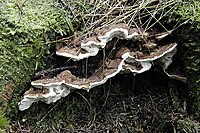
Photo from wikipedia
Abstract Fungi from the genus Heterobasidion are among the most important pathogens of forest trees in Northern Hemisphere causing root rot and wood decay, while Phlebiopsis gigantea is a very… Click to show full abstract
Abstract Fungi from the genus Heterobasidion are among the most important pathogens of forest trees in Northern Hemisphere causing root rot and wood decay, while Phlebiopsis gigantea is a very common saprotrophic wood decay fungus. Both fungi are primary colonizers of freshly cut conifer stumps (through which Heterobasidion spp. accomplishes primary infections of tree root systems), thus both fungi are competing for the substrate. To date, P. gigantea is widely used as Heterobasidion spp. biocontrol agent. Hypothesis has been proposed that natural colonization of stumps by P. gigantea might also to some extent restrict infections by the pathogen. The main aim of the study was to assess the potential of natural infections of P. gigantea to restrict infection and spread of Heterobasidion spp. in Picea abies and Pinus sylvestris stumps. In total, 793 P. abies stumps and 1158 P. sylvestris stumps were examined in 24 sample plots located in the eastern part of Latvia. Of these, 325 (41.0%) P. abies stumps were infected by Heterobasidion spp., and 59 (7.4%) by P. gigantea, and 168 (14.5%) P. sylvestris stumps were infected by Heterobasidion spp., and 846 (73.1%) by P. gigantea. In P. abies, the observed Heterobasidion spp. infection frequencies were significantly (p
Journal Title: Biological Control
Year Published: 2020
Link to full text (if available)
Share on Social Media: Sign Up to like & get
recommendations!